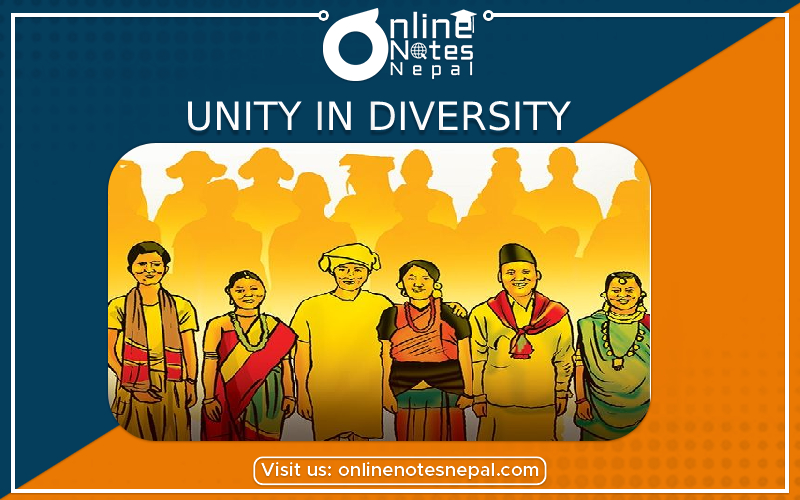Published by: Mandira
Published date: 17 Jan 2022

Unity means the state of being one and diversity means variation.Nepal is a small world in itself. It has diversity both in its physical and cultural aspects. Its physical diversity of climate and land form have encouraged diversity of races, caste, religion, language, food, costume, etc. its location between two large countries viz. china and India with distinctively different lifestyles has influenced the lifestyle respectively of southern and northern belt of the country and lifestyles of Nepalese people themselves are different in terms of regions, religions, castes, etc.
Hinduism, the eternal religion, followed by majority gave a conducive environment to Buddhism from the ancient time. Islam and Christianity along with some other religions could flourish amidst these two major religions later. Religious tolerance was highly maintained. Religious practices of people in Nepal right up to today overlap very often. Lumbini, the birthplace of Gautam Buddha, Swayambhu, Boudhanath, etc. are looked upon by Hindus as well with great reverence. Pashupati, Muktinath, etc are worshiped by Buddhists, too. They also celebrate several common religious and cultural festivals. It's a matter of pleasure that there have never been any serious religious riots in Nepalese societies.
Despite its small size, Nepal possesses very large ethnic variations. As remarked by King Prithvi Narayan Shah, it is a garden of four castes and thirty-six sub casts. According to the national census was taken in 2001 AD, there are more than 100 different caste in the country. Most of these castes have preserved their mother tongue languages, constitutionally recognized as languages of the nation (Rashtra Bhasha) besides the common Nepali language, the official language of the nation. All castes and sub-castes have preserved their special way of life in terms of their language, literature, costumes, music, dances, festivals, food, architecture, etc. all literature sing for unity and co-operation in the nation.
According to article 3 of Interim Constitution of Nepal 2063 BS, the Nepalese people with multiethnic, multilingual, multireligious, multicultural characteristics and having common aspirations and united by a bond of allegiance to national independence and integrity, national interest and prosperity collectively constitute the nation.
Nepali people are united linguistically and culturally. Irrespective of their differences, they are united in a common goal and national interest of peace and prosperity, independence, sovereignty and integrity. The forebears could defend the English attacks during Anglo-Nepal War through their collective efforts. Unity was also the key to the success of the revolutions and movements fought for democracy and public rights.
According to article 34, 'it will be the social objective of the state to create a harmonious social life based on justice and morality, by removing all sorts of socio-economic inequalities and establishing coordination between different races, castes, religions, languages, communities and creeds'.
Then according to article 35, 'the state will adopt a policy of strengthening national unity by maintaining cultural diversity through equal development of all's languages, literature, scripts, Arts and culture, by developing harmonious social relations based upon equality and coexistence of various religions, cultures, castes, creeds, communities, origins and languages'.
Diversity is our identity and unity are our specialties. Our cultures should be protected from the undue influence of foreign ones. Religious and cultural heritages should be preserved and promoted. Religious tolerance needs to be developed and practiced in more practicable ways. Prejudices like lingual, racial, regional, communal should be avoided. Mutual respect should be developed between all components of Nepalese population and people should march forward collectively for peace, prosperity and happiness of the nation.
The facts, data, knowledge or details of something of someone is referred as information. It is the data that is organized for a certain purpose. It is very important as it can affect the outcome, decisions and sometimes plans, policies, and laws. Thus, it must be always accurate.
Right to information is the right to obtain the sample of the verified documents or information. It is one of the recently identified rights in Nepal. It was guaranteed as a fundamental right by the Constitution of the Kingdom of Nepal 2047 B.S. It has been nearly two decades of its recognition as the fundamental right of Nepalese citizens.
Right to Information is defined in Section 2(e) of Right to Information Act, 2064 as:
Public Institutions
The public institutions of Nepal are as follows:
Public Importance
Rights under right to information
The following are the rights that come under the right to information:
Subjects which don't come under right to information
The following matters don't come under the right to information: